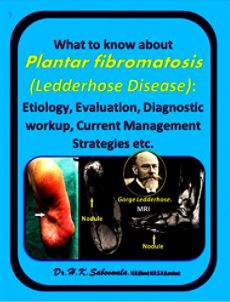
Plantar fibromatosis (PF), or Ledderhose disease as it is eponymously known, is a pathology of the plantar aponeurosis characterized by disordered fibrous tissue proliferation and the subsequent formation of nodules.
This condition can be locally aggressive, and often results in pain, functional disability, and decreased quality of life.
Diagnosis is primarily clinical, but MRI and ultrasound are useful confirmatory adjuncts.
Given the benign nature of this condition, treatment has historically involved symptomatic management.
A multitude of conservative treatment strategies supported by varying levels of evidence have been described mostly in small-scale trials.
These therapies include:
steroid injections,
verapamil,
radiation therapy,
extracorporeal shock wave therapy,
tamoxifen, and
collagenase.
When conservative measures fail, surgical removal of fibromas and adjacent plantar fascia is often done, although recurrence is common.
An attempt has been made in this Booklet to discus the aims to provide a broad overview of the clinical features of Ledderhose Disease as well as the current treatment strategies being employed in the management of this condition.














